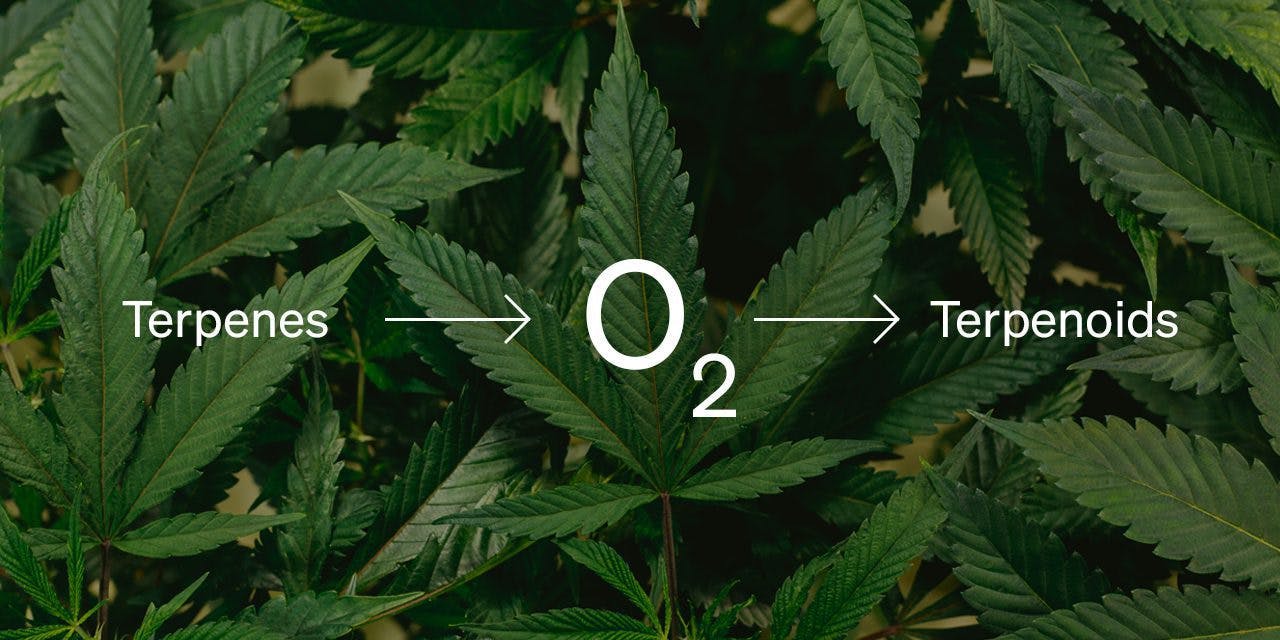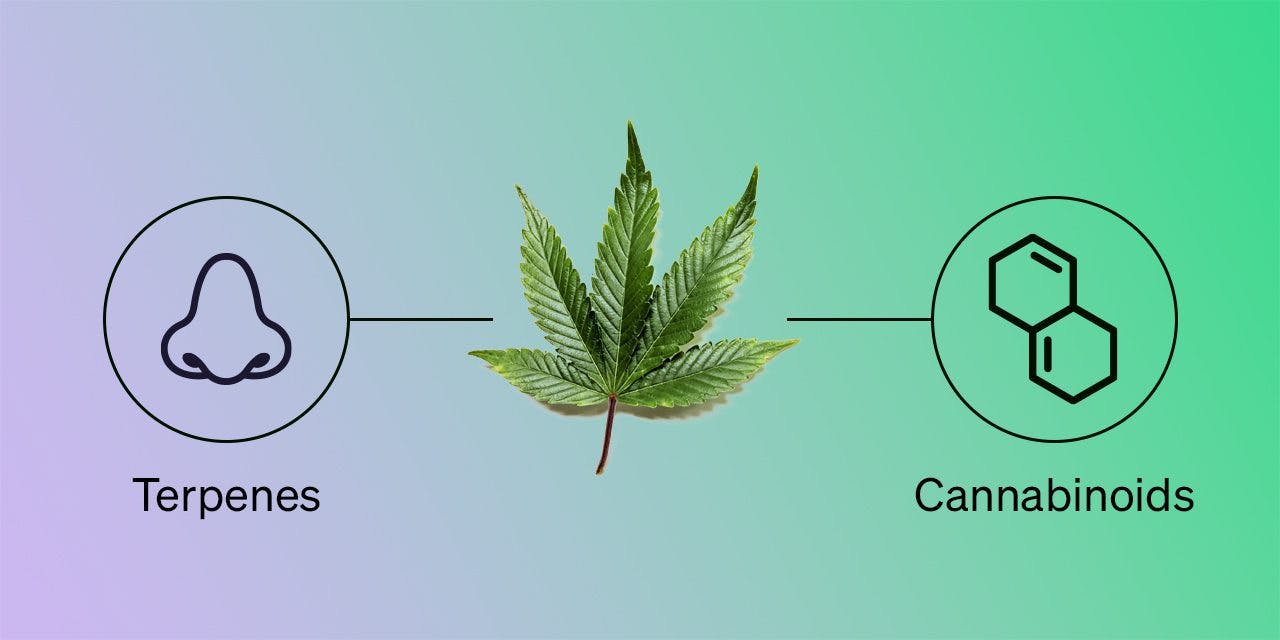What’s the Difference Between Terpenes and Terpenoids

Article written by

Dipak HemrajHead of Research and Education
Content reviewed by

Dr. Lewis JasseyMedical Director - Pediatric Medicine
Terpenoids are derived from terpenes through oxygenation, making the presence of oxygen atoms the main difference between the two. This slight difference could be why the compounds can have different effects. However, terpenoids are actually a vast class of chemical compounds. All terpenes are terpenoids, and all cannabinoids are also technically terpenoids! Both cannabinoids and terpenes are a subclass of terpenoids!
Terpenes and terpenoids are found within the cannabis plant. In fact, they can be found in almost every plant, flower, fruit or vegetable. Of the 20,000 terpenes found in nature, 200 of those are found in the cannabis plant. In addition to those, about 150 terpenoids have also been identified in marijuana.
There are many more terpenes and terpenoids than phytocannabinoids in cannabis. Since terpenes are ubiquitous in nature, they are legal. In comparison, cannabinoids are still illegal in many countries. As a result, more researchers are investigating the effects of terpenes and terpenoids because they are more accessible than cannabis. Studies show that terpenes can mimic and enhance the actions of cannabinoids, and using the two concurrently can produce pain-relieving effects greater than using terpenes or cannabinoids on their own.
Many cannabis terpenes and terpenoids are also present in common foods most people eat daily. These foods include citrus fruits, carrots, spices and herbs.
Get your medical marijuana card
Connect with a licensed physician online in minutes.
What Are Terpenes?
Terpenes are volatile compounds that consist of carbon and hydrogen atoms arranged in isoprene units. They are found in most plant products, including all strains of cannabis. Besides giving plants an aroma or fragrance, they might also influence the taste and color. Some different terpenes offer therapeutic advantages.
How Terpenes Work
Some terpenes can exert a biological effect on the human body, whereas others might have little to none. For example, some of the terpenes found in cannabis have an entourage effect with cannabinoids like delta-9-THC and CBD.
The entourage effect suggests that all components of the cannabis plant work in combination to exert an effect. So while THC and CBD are the primary active compounds, they work better alongside other components of cannabis, such as terpenes.
Commonly Known Terpenes
Here is a list of the most commonly known terpenes. Large quantities of these terpenes exist in some cannabis strains and are also present in other common plants.
Here we will explain those terpenes in further detail.
Download Free Guide to Beta-Caryophyllene
Pinene
Pinene gets its name from pine because of the aroma it has. Besides cannabis, pinene is also present in pine resin and herbs. Studies have shown that pinene could provide anti-inflammatory effects and improve the respiratory system.
Myrcene
Myrcene is found in cannabis, citrus fruits, pomegranates and carrots. Researchers think that myrcene could be a potential anti-cancer therapy. There is also some evidence suggesting that myrcene could have a synergistic effect with CBD. On its own, myrcene can also reduce anxiety because it has a calming and relaxing effect.
Linalool
Linalool is also present in herbs such as coriander. Linalool is another terpene that could have therapeutic potential for strokes, Alzheimer’s disease, inflammation and neuropathic pain.
Limonene
Limonene is said to make people feel alert. This terpene is commonly found alongside THC and may slightly add to THC’s effects.
Eucalyptol
The main constituent of eucalyptus oil is eucalyptol, and it is also present in several herbs. Some studies have also demonstrated that eucalyptol could have anti-cancer effects.
Caryophyllene
Some evidence has suggested that caryophyllene may bind to the same receptors as THC. However, it is known to have a synergistic effect with THC and will contribute to the effects of THC.
What Are Terpenoids?
Terpenoids are derived from terpenes through oxygenation . Terpenoids are also found in many plant products, including all strains of cannabis. So far, about 150 different terpenoids have been identified in the cannabis plant. Terpenoids have similar characteristics to terpenes by influencing the fragrance or odor of a plant, while some also have physiological effects.
How Terpenoids Work
Currently, there is little scientific research about how terpenoids work, but one study may have ruled out the possibility of terpenoids contributing to the entourage effect.
Chemically, terpenoids are slightly different from terpenes, so they might work differently in the body. Despite this, some terpenoids might be able to bind the cannabinoid receptors. Also, terpenoids are related to both cannabinoids and terpenes, with some even arguing that all cannabinoids are terpenoids! This suggests that terpenoids are also involved in the entourage effect in some way.
Commonly Known Terpenoids
Here is a list of the most commonly known terpenoids. Considerable quantities of these compounds exist in some cannabis strains.
- Linalool oxide
- Sabinene hydrate
- Nerolidol
- Humulene epoxide
- Cubebol
Terpenes and Terpenoids in Cannabis
Terpenes and terpenoids are abundant in cannabis. There is a theory that the cannabinoid compounds within the cannabis plant could be derived from terpenoids, which makes sense given that some of the structural aspects of the cannabinoids share similarities. However, while the terpenes and terpenoids in cannabis appear to be very similar, there are also some differences.
Similarities
When discussing the similarities between terpenes and terpenoids, it largely depends on their context. In terms of their chemical structure, they are very similar. Both types are volatile compounds that consist of isoprene units.
More generally, most terpenes and terpenoids may have some individual effect. However, most terpenes and terpenoids appear to have antimicrobial, antiparasitic, antioxidant and anticancer properties.
Differences
The main difference is that terpenoids are oxygenated forms of terpenes. When certain terpenes undergo chemical reactions, they acquire an oxygen atom, and this alters the structure and function of the molecule.
One study suggests that terpenoids do not mediate an entourage effect by acting at cannabinoid receptors. The same study comes to the same conclusion regarding terpenes, with the exception of beta-caryophyllene. However, terpenoids may still influence the behavior of cannabinoids, affect other receptor systems and mimic the action of cannabinoids (cannabimimetic), so they may still play a part in the entourage effect overall.
The Bottom Line
Terpenes and terpenoids are two types of compounds found in the cannabis plant. These compounds are gaining more attention since they are widespread and offer several therapeutic effects. In terms of cannabis, terpenes may enhance the effects of THC or CBD through the entourage effect. Little is known about terpenoid-cannabinoid interaction.
Get Your Medical Marijuana Card
Connect with a licensed physician online in minutes.



